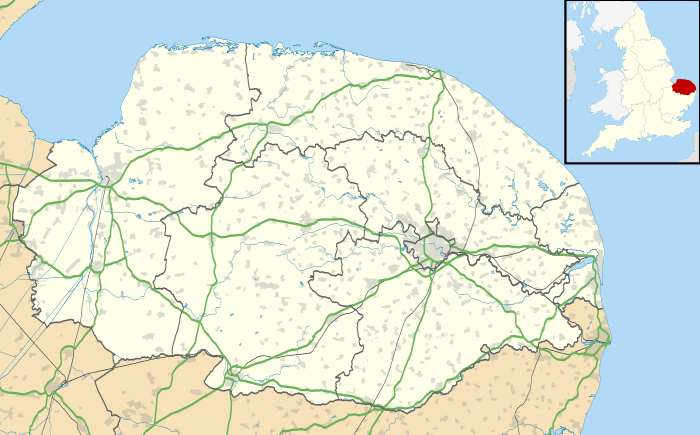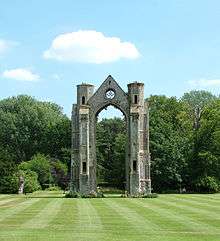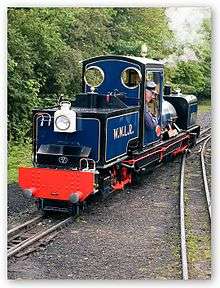Walsingham
| Walsingham | |
 Walsingham |
|
| Area | 18.98 km2 (7.33 sq mi) |
|---|---|
| Population | 819 (2011) |
| – density | 43/km2 (110/sq mi) |
| OS grid reference | TF934368 |
| District | North Norfolk |
| Shire county | Norfolk |
| Region | East |
| Country | England |
| Sovereign state | United Kingdom |
| Post town | WALSINGHAM |
| Postcode district | NR22 |
| Police | Norfolk |
| Fire | Norfolk |
| Ambulance | East of England |
| EU Parliament | East of England |
| UK Parliament | Broadland |
Coordinates: 52°53′38″N 0°52′25″E / 52.89385°N 0.87357°E
Walsingham is a village (actually two conjoined villages: Little Walsingham and Great Walsingham) in the English county of Norfolk. The village is famed for its religious shrines in honour of the Virgin Mary and is a major pilgrimage centre. It also contains the ruins of two medieval monastic houses.[1][2]
The civil parish, which includes the two Walsinghams, together with the depopulated medieval village of Egmere (grid reference TF 897 374), has an area of 18.98 km² and in the 2001 census had a population of 864 in 397 households, the population decreasing to 819 at the 2011 census.[3] For the purposes of local government the parish falls within the district of North Norfolk.[4]
Walsingham became a major centre of pilgrimage. In 1061, according to the Walsingham legend, a Saxon noblewoman, Richeldis de Faverches, had a vision of the Virgin Mary in which she was instructed to build a replica of the house of the Holy Family in Nazareth in honour of the Annunciation. Her family name does not appear in the Domesday Book.
When it was built, the Holy House in Walsingham was panelled with wood and contained a wooden statue of an enthroned Virgin Mary with the child Jesus seated on her lap. Among its relics was a phial of the Virgin's milk.
Walsingham became one of northern Europe's great places of pilgrimage and remained so through most of the Middle Ages.
Governance
An electoral ward in the same name exists. This ward stretches south to Sculthorpe with a total population taken at the 2011 census of 2,167.[5]
Priory
A priory of Canons Regular was established on the site in 1153, a few miles from the sea in the northern part of Norfolk and it grew in importance over the following centuries. Founded in the time of Edward the Confessor, the Chapel of Our Lady of Walsingham was confirmed to the Augustinian Canons a century later and enclosed within the priory. From the first, the shrine was a famous place of pilgrimage and the faithful came from all parts of England and the Continent until the destruction of the priory under King Henry VIII in 1538. To this day the main road of the pilgrims through Newmarket, Brandon and Fakenham is still called the Palmers' (Pilgrims') Way.
Many were the gifts of lands, rents and churches to the canons of Walsingham and many were the miracles sought and claimed at the shrine. Several English kings visited the shrine, including Henry III (1231 or 1241), Edward I (1289 and 1296), Edward II in 1315, Edward III in 1361, Henry VI in 1455, Henry VII in 1487 and finally Henry VIII, who was later responsible for its destruction when the shrine and abbey perished in the Dissolution of the Monasteries. Erasmus, in fulfilment of a vow, made a pilgrimage from Cambridge in 1511 and left as his offering a set of Greek verses expressive of his piety. Thirteen years later he wrote his colloquy on pilgrimages, wherein the wealth and magnificence of Walsingham are set forth and some of the reputed miracles rationalised. Two of Henry VIII's wives – Catherine of Aragon and Anne Boleyn – made pilgrimages to the shrine.


In 1537 while the last Prior, Richard Vowell, was paying obsequious respect to Thomas Cromwell, the Sub-Prior, Nicholas Mileham, was charged with conspiring to rebel against the suppression of the lesser monasteries and, on flimsy evidence, was convicted of high treason and hanged outside the Priory walls. Eleven people in all, including two lay choristers who had been instrumental in organising the revolt were hanged, drawn and quartered. What they feared would happen came the following year. In the July Prior Vowell assented to the destruction of Walsingham Priory and assisted the king's commissioners in the removal of the figure of Our Lady and many of the gold and silver ornaments and in the general spoliation of the shrine. For his ready compliance the Prior received a pension of 100 pounds a year, a large sum in those days, while 15 of the canons received pensions varying from four to six pounds. With the shrine dismantled and the priory destroyed, the site was sold by order of Henry VIII to Thomas Sidney for 90 pounds and a private mansion was subsequently erected on the spot. Gold and silver from the shrine was taken to London along with the statue of Mary and John (Jesus) which was later burnt.
The fall of the monastery gave rise to the anonymous Elizabethan ballad, The Walsingham Lament, on what the Norfolk people felt at the loss of their Shrine of Our Lady of Walsingham. The ballad includes the lines:
- Weep Weep O Walsingam,
- Whose dayes are nights,
- Blessings turned to blasphemies,
- Holy deeds to despites
- Sinne is where our Ladye sate,
- Heaven turned is to helle;
- Satan sitthe where our Lord did swaye,
- Walsingham O farewell!
20th century revival
By a re script of 6 February 1897 Pope Leo XIII blessed a new statue 'for the restored ancient sanctuary of Our Lady of Walsingham'. This was sent from Rome and placed in the Holy House Chapel at the newly built Roman Catholic parish church of King's Lynn (the village of Walsingham was within the parish) on 19 August 1897 and on the following day the first post-Reformation pilgrimage took place to the Slipper Chapel at Walsingham, which was purchased by Charlotte Boyd(e) in 1895 and restored for Catholic use. Hundreds of Catholics attended the pilgrimage and committed themselves to an annual pilgrimage (from 1897–1934 on Whitsun) to commemorate this event. Archives are kept at King's Lynn and Walsingham.
In 1900 a caretaker was placed in the Priest's House at the Slipper Chapel (said to have been built in 1338); to facilitate its use by Catholic pilgrims, under the custody of the monks at Downside Abbey. Both Father Wrigglesworth (the Catholic parish priest of King's Lynn and Walsingham) and Father Fletcher (Founder and Master of the Guild of Ransom) laid the foundations and left others to declare the Catholic National Shrine at the Slipper Chapel on 19 August 1934 with over 10,000 pilgrims present. Attempts to purchase the abbey site were unsuccessful (even though one of the Lee-Warners became a Catholic in 1899); however in 1961 the site of the original Holy House within the priory ruins was excavated by members of the Royal Archaeological Institute.[6]


As a result of the initiative of the Anglican vicar of Walsingham (from 1921), Father Alfred Hope Patten, an Anglican Marian shrine has been established in Walsingham. Building began in 1931 and pilgrimages are now held through the summer months.
The Anglican National Pilgrimage takes place on the Spring Bank Holiday (the Monday following the last Sunday in May) and is regularly met by Protestant picket lines. The Student Cross pilgrimage on Good Friday visits both the Anglican and Catholic shrines and the National Youth Pilgrimage is in the first week of August, also visiting the Anglican shrine.
The Catholic shrine continues to be based at the Slipper Chapel, near the hamlet of Houghton St Giles. Many significant occasions have been celebrated here, including the Pilgrimage of Catholic Youth (1938), the Cross Carrying Pilgrimages (since 1948), and the Crowning of Our Lady (Marian year 1954 and 1988). On 22 May 1982, the statue of Our Lady of Walsingham was taken to Pope John Paul II at the Wembley Mass and given a place of honour during his British visit. In 2000, a new Feast of Our Lady of Walsingham was approved by the hierarchy, to be celebrated in England and Wales on 24 September.
Ecumenical opportunities have been seen in Walsingham, and there is an interaction between the two shrines. In the Anglican shrine there is a small Orthodox chapel. The Orthodox have a further presence at the Church of the Holy Transfiguration situated at Great Walsingham and also at the former Little Walsingham railway station which has been converted into the Greek Orthodox church of St Seraphim.
Wells and Walsingham Light Railway


Walsingham used to be connected to the railway network by the Norwich via Fakenham, Dereham and Wymondham route, but this was axed during the Beeching era in the late 1960s, in stages from 1964 to 1969.
In 1979 work began on constructing a 10 1⁄4 in (260 mm) gauge heritage railway on the old track bed to Wells. The line re-opened in 1982 and now operates with a fleet of steam and diesel scale locomotives.
A new station was constructed in Walsingham. The old station building (with platform still intact and visible) is now Saint Seraphim's Orthodox church.
Other places in the world named Walsingham
- Walsingham, Ontario, Canada
- Walsingham, Canterbury, New Zealand
- Walsingham, in Hamilton, Bermuda
- Walsingham Bay, in the area of Walsingham, Bermuda.
See also
- Slipper Chapel
- Religion in the United Kingdom
- Walsingham House School, Bombay India
- East Anglia Diocese
- Catholic Association Pilgrimage
- Student Cross Pilgrimage
- Personal Ordinariate of Our Lady of Walsingham
References
- ↑ Ordnance Survey (2002). OS Explorer Map 251 – Norfolk Coast Central. ISBN 0-319-21887-2.
- ↑ "Welcome to Walsingham". Walsingham Parish Council Clerk. Retrieved 7 June 2006.
- ↑ "Civil Parish population 2011". Retrieved 3 September 2015.
- ↑ Office for National Statistics & Norfolk County Council (2001). Census population and household counts for unparished urban areas and all parishes. Retrieved 2 December 2005.
- ↑ "Ward population 2011". Retrieved 3 September 2015.
- ↑ "Catholic Association". Catholic Association. Retrieved 9 August 2013.
Sources and external links
| Wikimedia Commons has media related to Walsingham. |
- Walsingham Abbey website
- Walsingham history website
 This article incorporates text from a publication now in the public domain: Herbermann, Charles, ed. (1913). "article name needed". Catholic Encyclopedia. New York: Robert Appleton.
This article incorporates text from a publication now in the public domain: Herbermann, Charles, ed. (1913). "article name needed". Catholic Encyclopedia. New York: Robert Appleton.- Map sources for Walsingham
- Information from Genuki Norfolk on Walsingham.
- Walsingham Village Website including information from Walsingham Parish Council and other groups in the village
- Walsingham Shrines website
- Wells and Walsingham Light Railway
- Little Walsingham Photographs
- Brian Whelan official website
- The Walsingham Village Hall Website
- Orthodox Church of the Holy Transfiguration, Great Walsingham
